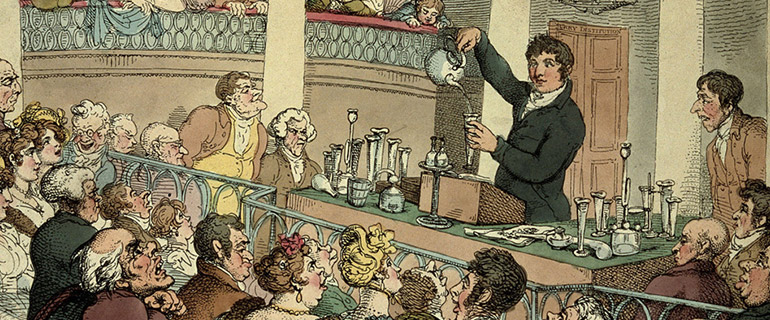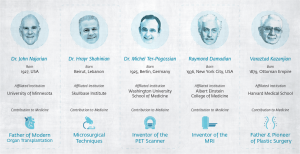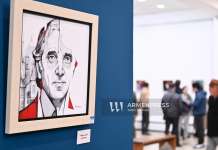Armenia is making its mark as a global medical tourism hub, yet to the keen observer, this should come as no surprise. Despite its tiny size, this caucasian nation has contributed disproportionately to the medical profession, through advances in medical research over the course of many centuries. Armenians have been found in every aspect of medical innovation, from the publication of Mkhitar Heratsi’s ‘Relief of Fevers’ in 1184 to the pioneering work of Drs. Simeon Minasian, Garabed Galstian, and Baronig Matevosian during the American Civil War, though their contribution goes much deeper.
Armenian doctors, medical researchers and inventors are responsible for some of the most important life-saving innovations of the last century.
1- Varaztad Kazanjian: Father of Modern Plastic Surgery
The Invention:
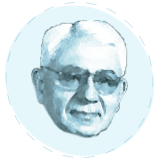 As a young man, Varaztad Kazanjian fled the Ottoman Empire, where he worked in a local post-office due to the anti-Armenian pogroms known as the Hamidian Massacre. Settling in Boston to start a new life, Varaztad started working at a local wiring factory, where his extraordinary dexterity with tools led him to study dentistry at Harvard. During the Great War, Kazanjian was sent on a medical mission to the battlefields of France. Despite being trained as a dentist, his compassion for the sheer number of soldiers with horrific facial wounds he met lead him to experiment with various treatments. The innovative procedures he worked with were often accomplished in primitive conditions, in field hospitals near the front lines.
As a young man, Varaztad Kazanjian fled the Ottoman Empire, where he worked in a local post-office due to the anti-Armenian pogroms known as the Hamidian Massacre. Settling in Boston to start a new life, Varaztad started working at a local wiring factory, where his extraordinary dexterity with tools led him to study dentistry at Harvard. During the Great War, Kazanjian was sent on a medical mission to the battlefields of France. Despite being trained as a dentist, his compassion for the sheer number of soldiers with horrific facial wounds he met lead him to experiment with various treatments. The innovative procedures he worked with were often accomplished in primitive conditions, in field hospitals near the front lines.
Why it’s important:
Dr. Kazanjian’s pioneering procedures directly lead to establishing the medical field of plastic surgery, earning him the prestigious position of first ever Professor of Plastic Surgery at Harvard. His efforts didn’t go unrecognised by others either. He was awarded the Order of Saint Michael and Saint George by HM King George V of Great Britain, as well as the Honorary Award of the American Society of Plastic and Reconstructive Surgeons.
His work helped propel battlefield medicine into the 20th century, allowing many wounded soldiers to recover from some of the most horrific wounds brought by modern warfare. These techniques eventually became commonplace in the civilian world as well. Victims of crashes, burns, and other accidents now had access to some of the most cutting-edge facial reconstruction technology in human history.
The importance of Dr.Kazanjian’s efforts may go unnoticed for today’s casual consumers of cosmetic plastic surgery, but it’s worth remembering that the history of perfect noses and perfect breasts starts with an Armenian dentist’s struggle to stitch up wounded soldiers of World War One.
2- Michel Ter-Pogossian: PET scan
The Invention:
 The Positron Emissions Tomography scanner, better known to the layperson as the PET scan, is one of the most recognisable pieces of medical technology today, but had it not been for the efforts of the German-Armenian nuclear physicist Michel Ter-Pogossian, this may not have been the case.
The Positron Emissions Tomography scanner, better known to the layperson as the PET scan, is one of the most recognisable pieces of medical technology today, but had it not been for the efforts of the German-Armenian nuclear physicist Michel Ter-Pogossian, this may not have been the case.
A son of Armenian Genocide survivors, Michel Ter-Pogossian was born in Berlin, Germany in 1925. Having witnessed the rise of the Nazis, his family quickly eed to France when he was still a child. Michel was not ready to let his adopted country fall to the same fate as his birth place. He promptly took up the fight against the Nazis as part of the French Resistance Movement during WWII while earning his degree at the University of Paris’s Institute of Radium. He continued his studies after immigrating to Missouri in 1946, where he attended classes at the Washington University of St. Louis, eventually securing a faculty seat in its School of Medicine.
Why it’s important:
His most notable contribution to Science, the PET scanner is known as one of the most promising methods of detecting early stages of cancer, as well as for monitoring heart disease, allowing millions of people to identify these life-threatening diseases in time to treat them.
3- Raymond Vahan Damadian: Inventor of the MRI
The Invention:
 If most of us ever confuse the PET scanner with anything else, it’s almost always the MRI Machine, but that’s OK, because the MRI was also an Armenian invention; This time, by the Armenian-American physician, Raymond Vahan Damadian.
If most of us ever confuse the PET scanner with anything else, it’s almost always the MRI Machine, but that’s OK, because the MRI was also an Armenian invention; This time, by the Armenian-American physician, Raymond Vahan Damadian.
Born to an Armenian family in New Mexico, Raymond had an early interest in the physical sciences. With a bachelor’s degree in mathematics already under his belt, he decided to pursue his interest in medicine, graduating as an M.D. from the Albert Einstein College of Medicine in 1960.
As a doctor, Raymond researched the effects of sodium and potassium in living cells, eventually leading him to his first experiments using nuclear magnetic resonance (NMR). Raymond conducted the first-ever diagnosis of cancer with a full-body scan in 1977 when he used his newly-invented Magnetic Resonance Imagine (MRI) machine on a patient. Despite controversy revolving around his being denied a Nobel Prize for the invention that many believed entitled him to, Damadian never stopped improving on his important research.
Why it’s important:
By inventing the MRI machine, Dr Damadian discovered a new way for medical professionals to diagnose cancer and conduct follow-ups without exposing the patient’s body to ionising radiation. This revolutionised the field of cancer researched, and allowed for easier and safer cancer diagnosis.
The MRI machine is also a very versatile as an imaging technique. Today, it is also widely used in biomedical research, as well as in the imaging of non-living objects. There are currently over 25 000 MRI machines used in hospitals and research labs across the world, used in diverse fields of research and medicine, including, but not limited to neurology, cardiovascular research, oncology, and much more. The MRI machine is even preferred to CT scanners when either technique could be used for the same effect.
4- Hrayr Shahinian: Pioneer in Microsurgical Techniques
The Invention:
 Hrayr Shahinian, M.D., F.A.C.S. is recognised as a pioneer of endoscopic surgical techniques, commonly used in order to treat all sorts of skull-based disorders. After graduating from the American University of Beirut in 1981, he continued on at the University of Chicago’s Medical School. Having completed fellowships at the Department of Head and Neck Surgery in the swiss city of Zurich, and in craniofacial surgery at New York University, Dr Shahinian was certified by the American Board of Surgery in 1992.
Hrayr Shahinian, M.D., F.A.C.S. is recognised as a pioneer of endoscopic surgical techniques, commonly used in order to treat all sorts of skull-based disorders. After graduating from the American University of Beirut in 1981, he continued on at the University of Chicago’s Medical School. Having completed fellowships at the Department of Head and Neck Surgery in the swiss city of Zurich, and in craniofacial surgery at New York University, Dr Shahinian was certified by the American Board of Surgery in 1992.
Why it’s important:
Dr Shahinian’s new techniques provide a less invasive alternative to older neurosurgical technology. His pioneering endoscopic approach has since widely replaced traditional techniques across the United States and is being used around the world from Canada to South Korea. He has published over 80 academic papers on endoscopic techniques.
Dr Shahinian has since received numerous awards for his work and has secured various patents. he was also honoured by NASA for his work in the field of advanced medical technology.
5- Dr John Najarian: Father of modern Organ Transplantation
The Invention:
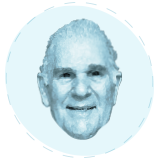 Though organ transplant procedures have been attempted for decades, a high rate of rejection by the patient’s immune system made the operation extremely dangerous and incurred a high probability of failure. This all changed thanks to the pioneering work of Dr John Najarian.
Though organ transplant procedures have been attempted for decades, a high rate of rejection by the patient’s immune system made the operation extremely dangerous and incurred a high probability of failure. This all changed thanks to the pioneering work of Dr John Najarian.
Why it’s important:
The medical field that Dr Najarian entered back in the early 1950s was quite different from what it is today. Modern organ transplant techniques were in their infancy when a young John Najarian was considering cardiology as a career option. The first successful kidney transplant in 1954 lead him to reconsider his path, leading him to proclaim: “That’s the field, that’s something. If you can put in an organ in an individual and save his life, that is remarkable and that’s the direction I want to go.” From that point on, Dr Najarian concentrated his efforts in immunology in order to facilitate kidney transplants, which until then had been complicated by a high rejection rate by the body.
As the first surgeon in the world to conduct successful pancreas and kidney transplants, his invention garnered him both praise and controversy over the years. Despite overseeing the development and manufacture of AntiLymphocyte Globulin (better known through the acronym “ALG”), which helped patients bodies’ recognise and accept foreign organs, for over 25 years at the University of Minnesota, his programme was eventually shut down by the FDA because it had never received its approval. Despite Dr Najarian eventually being cleared of all charges, the damage to his institution had already been done. His research facility had lost a lot of funding, and a lot of skilled researchers.
Despite this major setback, his groundbreaking research and contribution to his field was recognised by many. Dr Najarian even recalls: “To this day I can’t walk down the street and people don’t come up and shake my hand. It’s the most amazing thing in the world”. After all, he managed to save the lives of countless millions with his breakthroughs in organ transplants.
………..
Though the field of medicine is the result of the collective effort that has been propelled by the work of thousands upon thousands of doctors, scientists, and inventors across millennia, one should not discount the unique contribution of the inhabitants of a tiny nation, nestled between the high mountains of the Caucasus. Their endeavours have made now-mundane treatments such as Cancer prevention, plastic surgery, organ transplants, and microsurgery unmistakable parts of modern medicine, saving countless lives.
Many of the technologies and treatments which these men have pioneered exist in Armenia today, and can be accessed here.


